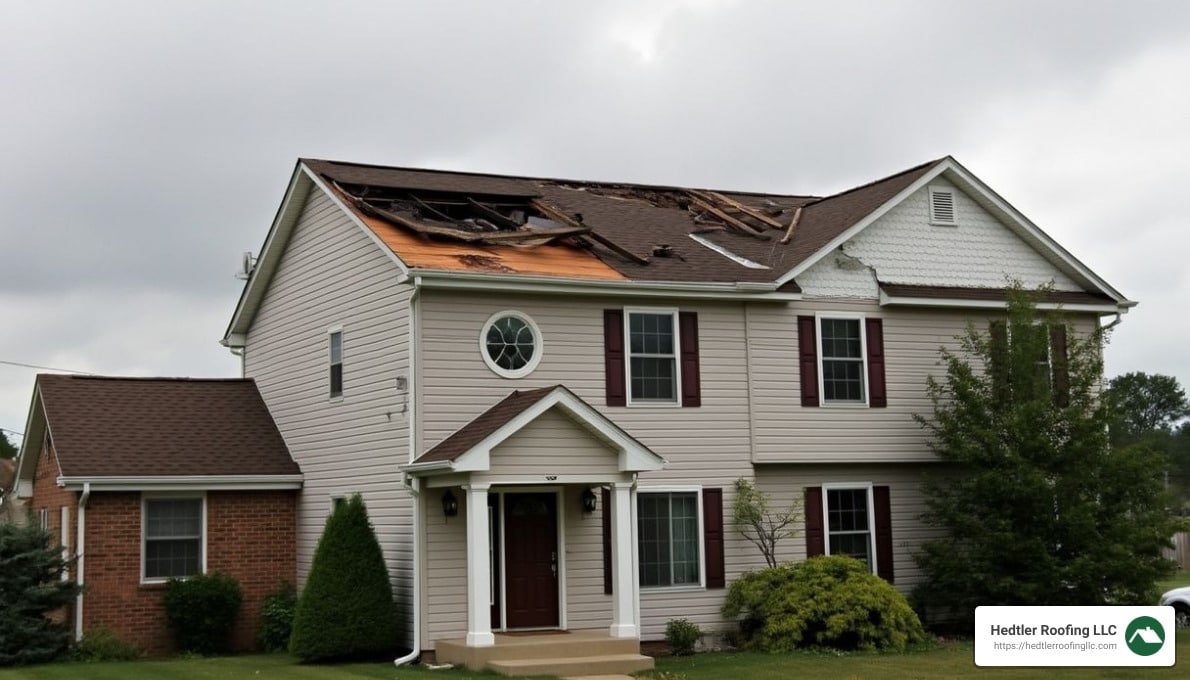Emergency Roof Tarping: Top 5 Essential Tips 2024
Emergency roof tarping is like a safety net for your home when disaster strikes. Whether it’s a raging storm or just the wear and tear of time, roof damage can happen unexpectedly. When it does, a swift response can mean the difference between a minor hiccup and a major catastrophe.
Quick facts about emergency roof tarping:
- It’s a temporary fix to cover damaged roofs.
- It protects against leaks, mold, and further structural damage.
- Professional installation is safer and more reliable.
- Contact trusted services immediately to limit damage.
At Roof Experts, we understand the urgency when it comes to sheltering your home. Roof damage doesn’t wait, and neither do we. We’re here to provide immediate solutions, ensuring your family stays safe and dry in Franklin and Bellingham, MA.
My name is Jason Hedtler, and I’ve been at the forefront of providing resilient roofing solutions in Massachusetts for years. Let me guide you in understanding how emergency roof tarping can safeguard your home and give you peace of mind.

Emergency roof tarping terms at a glance:
– Roof Repairs in MA
– roof leak repair near me
– roof repair and replacement massachusetts
Understanding Emergency Roof Tarping
When your roof suffers damage, emergency roof tarping becomes a crucial first step. It’s a temporary solution that acts as a shield, preventing further harm to your home. By covering exposed areas, tarping stops leaks, wards off mold, and helps maintain the structural integrity of your house. This quick action can save homeowners thousands in additional repair costs.
Importance of Tarping
Consider tarping as your home’s first line of defense. A well-placed tarp prevents rain from seeping into your living spaces, which can lead to costly water damage and mold growth. Mold isn’t just a nuisance; it poses serious health risks.
Moreover, tarping helps keep your home’s structure sound. When water infiltrates, it can weaken beams and supports, leading to more extensive damage over time. A tarp acts as a barrier, keeping these elements dry and intact until permanent repairs can be made.

Materials and Tools Needed
To successfully perform emergency roof tarping, you’ll need the right materials and tools. Here’s a quick checklist:
- Tarp: Choose a heavy-duty, waterproof tarp that’s large enough to cover the damaged area with some overlap.
- Plywood: Use plywood to support the tarp and prevent it from sagging, especially if the area is large.
- Nails: Secure the tarp and plywood with nails. Opt for roofing nails, as they are designed to withstand outdoor conditions.
- Drills: A drill makes it easier to attach plywood and secure the tarp, especially on tougher surfaces.
- Ladders: Ensure you have a sturdy ladder to safely reach the roof. Safety should always be a priority.
While it’s possible to gather these tools on your own, working on a roof can be hazardous. For those in Massachusetts, Roof Experts offers professional and safe tarping services to ensure your home is protected without risking personal safety.
How to Tarp a Roof Temporarily
Step-by-Step Process
Tarping a roof might seem straightforward, but it requires careful execution to ensure effectiveness. Here’s a simple guide to help you through the process:
- Assess the Damage: Before you start, inspect the roof to understand the extent of the damage. Look for missing shingles, holes, or structural issues. Ensure that it’s safe to proceed. If you’re unsure, it’s best to call a professional.
- Measure the Surface Area: Accurately measure the damaged area to determine the tarp size you’ll need. It’s essential that the tarp extends a few feet beyond the damaged section on all sides to ensure complete coverage and secure anchoring.
- Lay Plywood: For larger areas, lay plywood over the damaged sections. This provides a solid surface to support the tarp and prevents sagging, which can lead to water pooling.
- Position the Tarp: Carefully spread the tarp over the plywood and the damaged area. Ensure that it is smooth and taut to prevent water from collecting.
- Secure with Strapping: Use wooden boards or strips to secure the tarp. Nail these boards into the roof rafters, not just the sheathing, for a more secure hold. This method helps in keeping the tarp firmly in place during windy conditions.
Safety Considerations
While tarping can be a temporary fix, safety should always be the top priority. Here are some key considerations:
- Professional Help: It’s highly recommended to seek professional assistance, especially if you’re dealing with extensive damage or if the roof is difficult to access. Professionals have the experience and equipment necessary to perform the job safely and effectively.
- Avoid DIY: While the DIY approach might save money, it can be risky. Without proper training and equipment, you could inadvertently cause more damage or injure yourself. In Massachusetts, Roof Experts provides expert tarping services, ensuring safety and quality.
- Potential Hazards: Working on a roof involves several risks, including falls, tool-related injuries, and exposure to the elements. Always use proper safety gear like harnesses, non-slip shoes, and helmets. Ensure that the ladder is stable and positioned correctly before climbing.
By following these steps and precautions, you can effectively protect your home until permanent repairs are made. Next, we’ll explore the costs associated with emergency roof tarping and how to decide between DIY and professional services.
Cost of Emergency Roof Tarping
When it comes to emergency roof tarping, understanding the costs involved is crucial for making informed decisions. Whether you choose a DIY approach or hire professionals, several factors will influence the overall expenses.
DIY vs. Professional Services
DIY Tarping: Opting for a DIY solution can initially seem like a cost-effective choice. You’ll mainly incur material costs, which can range from $150 to $350 for a tarp covering an average 1500-square-foot roof. However, the risks associated with DIY tarping—such as personal injury or further roof damage—can outweigh the savings.
Professional Services: Hiring experts like Roof Experts ensures safety and efficiency. Professionals charge for materials and labor, with average hourly rates around $60. The total cost for a 1500-square-foot roof can range from $1200 to $1500. This might seem higher than DIY, but it covers expert handling, which minimizes risks and ensures a secure installation.
Factors Influencing Costs
Emergency Service Rates: When you need immediate assistance, expect to pay a premium. Emergency services typically cost 1.5 times the standard hourly rate. This surcharge reflects the urgency and the need for quick response, which is vital in preventing further damage.
Material Costs: The price of tarps and securing materials can vary based on quality and size. Larger roofs or those requiring specialized materials will naturally incur higher costs.
Labor Costs: Labor expenses depend on the complexity of the roof and the extent of the damage. Roofs that are difficult to access or require extensive preparation will cost more in terms of labor hours.
Roof Size and Damage Severity: Larger roofs or those with significant damage will require more materials and time, impacting the overall cost. A minor patch job will be much cheaper than covering a substantial portion of the roof.
Accessibility: Roofs that are easy to access might reduce labor costs. Conversely, steep or multi-story roofs can require additional safety measures, increasing the time and cost of the project.
In summary, while DIY tarping might save some money upfront, professional services offer a safer and more reliable solution. By understanding these cost factors, you can better plan for emergency situations and make decisions that protect your home and your wallet.
Next, we’ll look at alternatives to roof tarping and how they compare in terms of effectiveness and cost.
Alternatives to Roof Tarping
While emergency roof tarping is a common and effective temporary fix, there are alternatives that might better suit your situation, especially for Massachusetts homeowners facing unique weather challenges. Let’s explore some options:
Shrink Wrap Roof Seal
Shrink wrap roof seal is an innovative method that provides a tight, weather-resistant barrier over the damaged area. This technique involves wrapping the roof in a durable plastic film, which is then heated to shrink and seal it tightly against the roof structure.
- Advantages: It offers a more robust seal against water and wind compared to regular tarps. It also lasts longer, which can be crucial in prolonged repair situations.
- Considerations: This method can be more expensive and typically requires professional installation due to the specialized equipment and expertise needed.
Emergency Repairs
Sometimes, rather than just covering the damage, emergency repairs might be the best course of action. These are quick fixes that address the most critical issues, such as sealing leaks or reinforcing weak spots.
- Advantages: This approach can prevent additional damage and may reduce overall repair costs in the long run.
- Considerations: Emergency repairs are still temporary and will need to be followed by more permanent solutions. They can also be more expensive upfront compared to tarping.
Insurance Requirements
Before deciding on any temporary solution, understand your insurance requirements. Many insurance policies have specific conditions for covering roof damage.
- Documentation: Ensure that any temporary measures like tarping or shrink wrapping are documented. This can be crucial for insurance claims, as insurers often require proof that you’ve taken steps to mitigate further damage.
- Professional Services: Some insurance policies may only cover damages if repairs or temporary fixes are done by licensed professionals. Check with your provider to avoid any coverage issues.
In conclusion, while tarping is a popular choice, alternatives like shrink wrap and emergency repairs offer different benefits and may be better suited to certain situations. Always consider your specific needs, budget, and insurance requirements when choosing the best solution for protecting your home.
Next, we’ll address frequently asked questions about emergency roof tarping to help you make informed decisions.
Frequently Asked Questions about Emergency Roof Tarping
What is emergency roof tarping?
Emergency roof tarping is a temporary solution used to protect your home from further damage after the roof has been compromised. It involves covering the damaged area with a durable tarp to prevent water from entering and causing leaks, mold, or structural issues. This quick fix is essential to minimize damage until permanent repairs can be made. In Massachusetts, where weather can be unpredictable, tarping is a crucial step in safeguarding your home.
How long should a roof tarp stay in place?
A roof tarp is designed as a temporary measure. Generally, it can last anywhere from a few weeks to a few months, depending on the quality of the tarp and weather conditions. It’s important to schedule permanent repairs as soon as possible to avoid relying on the tarp for too long. Prolonged use can lead to additional problems, such as mold growth or structural rot.

Can I tarp my roof myself?
While it might be tempting to tackle the task yourself, it’s usually best to leave emergency roof tarping to professionals. Here’s why:
- Safety Concerns: Climbing onto a damaged roof can be dangerous without proper training and safety equipment. There’s a risk of falling or causing more damage.
- Proper Installation: Professionals ensure the tarp is secured correctly, which is crucial for effective protection. Improper installation can lead to leaks or the tarp blowing away in strong winds.
- Insurance Implications: Many insurance policies require that repairs or temporary fixes be done by licensed professionals to qualify for coverage. DIY attempts could void your claim.
In summary, while DIY is possible, the risks often outweigh the benefits. Hiring a professional ensures safety, effectiveness, and compliance with insurance requirements.
Conclusion
In Massachusetts, where unpredictable weather can lead to sudden roof damage, Roof Experts stands ready to help homeowners with their professional services. Based in Bellingham, we specialize in roof installations, replacements, and repairs, providing peace of mind to our community.
Why Choose Us?
- Expertise and Experience: With over 20 years in the industry, we understand the unique challenges Massachusetts homeowners face. Our team is skilled in handling all types of roofing issues, ensuring your home stays protected.
- Professional Service: We prioritize customer satisfaction by offering detailed inspections and high-quality workmanship. Our approach ensures that your roof not only looks great but also withstands the harsh New England weather.
- Local Knowledge: Being based in Massachusetts, we are familiar with local regulations and climate considerations, ensuring a smooth and compliant roofing project.
For Massachusetts homeowners, emergency roof tarping is a critical service that can prevent further damage and provide temporary relief. At Roof Experts, we offer this service along with comprehensive roofing solutions to keep your home safe and secure.
If you need assistance with your roof, don’t hesitate to contact us for a free, no-obligation estimate. Our team is here to help you steer any roofing challenges with expertise and care. Your satisfaction and safety are our top priorities.


